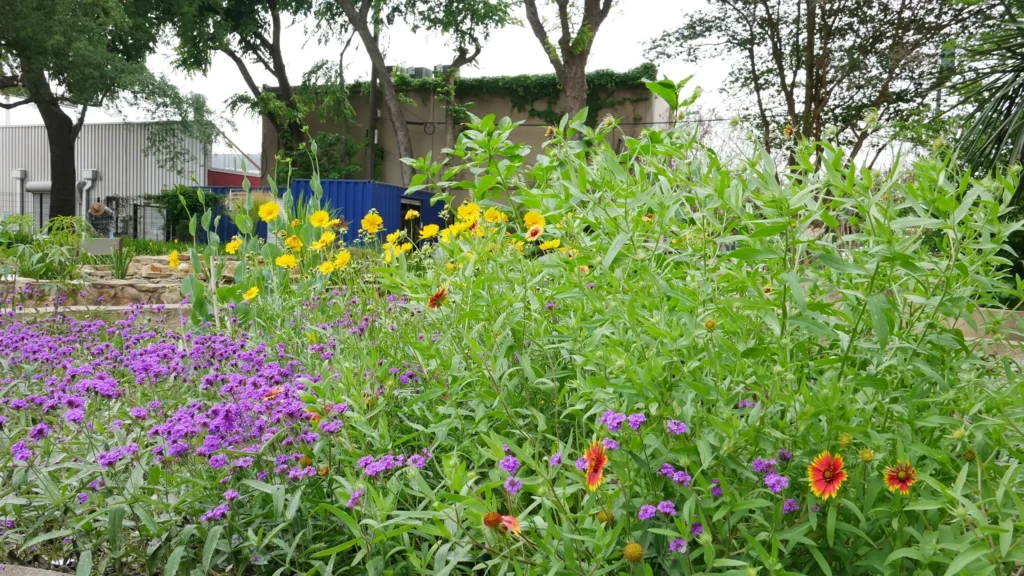
Ashley Powell, HCCC Curatorial Assistant, and Kathryn Hall, HCCC Curatorial Fellow, recently interviewed former resident artist, Christina Carfora, at the end of her residency. Christina is currently living in Denton, Texas, teaching ceramics at Texas Women’s University, working in her studio, and taking graduate classes.
Ashley Powell: We’ve noticed a relationship between your drawings and your ceramic sculptures. Can you tell us how they work together and inform each other?
Yes, the two are definitely very integrally tied together, and, often, when I’m working on a piece, I’ll start with a sketch. However, I sort of vacillate back and forth, and, as I’m working on a drawing, it often inspires other concepts and other pieces. When I’m working on my sculptures, I think of other ideas for drawings. I like this aspect of the drawings because you don’t have to deal with gravity like you do in the very structural ways when making sculptural work. When working on the sculptures, I really like getting the clay in my hands and being able to feel the tactile-ness. I also like the way people emotionally interact with the sculptural work on a different level.
Kathryn Hall: Speaking about that, and thinking about the limitations and features in working with clay versus drawing, what do you find is the biggest challenge when you’re constructing your work?
I deal with quite a few different challenges because I am working on a very large scale. I’m working life sized and figurative. So, all of these things need to be carefully considered before I start the process, and that’s part of the reason why I do a lot of drawings ahead of time. When I’m working on a figurative piece, I need to think about constraints such as: Will it fit in the kiln? Will it fit in my car? What aspects of it structurally could break at any time? I do make the works in parts that will then fit together to get around some of those challenges, and I often change some of the subtleties of the positions as well. In my larger pieces, I often build handles into the piece. So, if you were to look inside the leg area of some of the figurative pieces, they will have handles, so you can lift them up. And, in the Indonesian Epic piece, the bottom portion actually has circular handles of slab construction on the interior, so you can lift it.
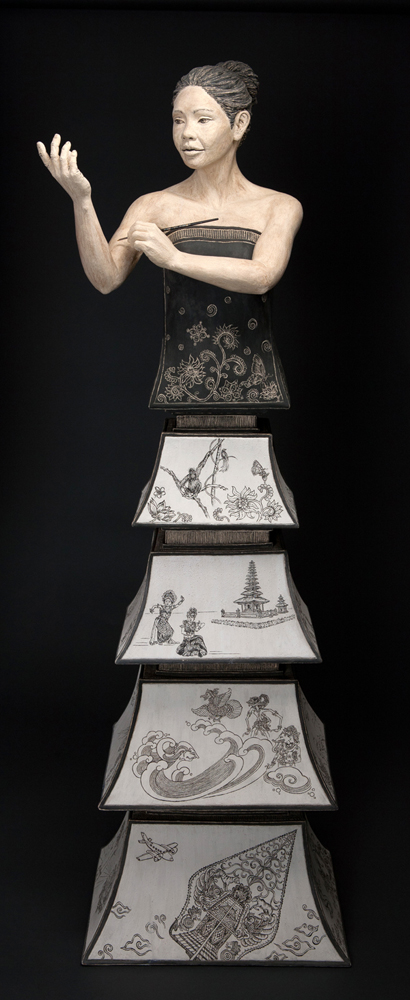
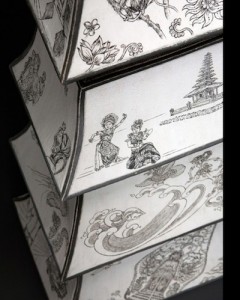
AP: They are all hollow construction, correct?
Yes, that’s right. They have to be hollow for many reasons. Some of the pieces being hollow already weigh 150 pounds or more. Also, because of the nature of the clay, you need to work approximately ½ to ¾ inches in thickness, but I often work quite thin for purposes of drying and cracking.
KH: I’ve noticed both your drawings and sculptures have a very animated, narrative quality. When you’re creating these drawings that are first informing your work, are you thinking about those little details that will be happening in the three-dimensional realm? Are you thinking about those types of details from the beginning or do those evolve as you go?
It’s kind of a combination of both. When I’m thinking about the larger scale works, I usually start with the title of the piece, which I know, for some artists, is an afterthought. And, for some artists, it is something that just comes along. But, for me, because I do tend to have quite a few ideas, it’s my way of honing things, focusing on them and also making sure every subtle aspect of the work is already in there. There are definitely things that happen and evolve naturally with the piece, but sometimes, in order to tell the story, a lot of those details are already in there, and I have an aesthetic for the way things are going to be rendered, alluding to a certain time period, place, or country. Some of the features just come about, but the majority of the details start at the beginning of the thought process.

AP: Throughout your career you’ve been an avid traveler. How has traveling influenced your work, and what place has inspired you the most? Where else do you plan to travel?
Traveling is definitely integrally tied to my work. My exhibition that’s going to be opening in June, 2014, at Lone Star College, is entitled Wanderlust. Traveling is something that’s a part of me. I was fortunate enough as a child to be able to take a lot of family vacations, driving and exploring different places, and that has sort of taken over a very big part of my way of thinking and my lifestyle. It’s nice because I have that drive and that need to go out and see the world and explore. Some of my most amazing experiences I’ve had have been on my travels. The traveling affects the way I look at the rest of the world and the way I deal with other people and situations. As far as the most influential place I have been, that’s a tricky question. I’ve travelled to 23 countries, and so I’ve covered a lot of ground already, and I have a huge list of places that I would still like to go. I guess because I lived in Indonesia, it was very inspirational and is very much a part of me. But, there were other monumental trips that happened. One of the first times I traveled outside of the United States or Europe was in undergrad. I spent the summer with the University of Wisconsin, Milwaukee, studying the textiles and the ceramics of Peru. So, Peru was my first big trip that I took that was very much outside of my comfort zone. I was nervous about it, and there were some political incidents that were happening right before I went. I remember lying in bed thinking about the worst nightmare scenarios and asking myself, “What am I doing? Is this insane?” And then, once I got there, I realized all my fears were unfounded. Also, when I was moving to Indonesia, I had a lot of apprehension about myself as a female traveler, and, once I got there, again, I realized that the majority of my fears were unfounded, and I just gained so much more from those experiences.
KH: Coming back to your work, do you have a particular piece that you created during your residency here that has made you feel the most accomplished?
I think the piece right now, that has been a great jumping off piece, would be the one you see behind me. (Second photo under this question) My proposal for my time at HCCC was to take those two-dimensional Unnatural History drawings and very directly reference them to bring them into the three-dimensional realm. This piece is one of those, and the drawing it’s from is The Invasion of a New Environment. It’s a hauntingly funny image of a tourist, and she has pretty much carried every personal belonging that she probably owns with her.
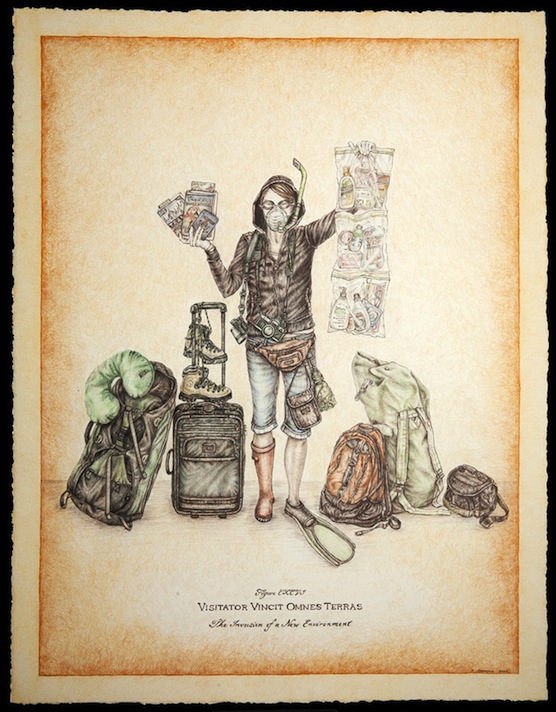
During my experiences traveling in Southeast Asia, I noticed that often people do try to recreate their own environment, even though they are in a very different one. Part of that, I understand–it’s human nature–and part of it is amusing to me, because, as a tourist, you’ve chosen to go there. Then, often times, you see people who don’t want to try the new foods or want all of their comforts of home with them. Also, it’s about our own human tendencies. I am fascinated by the concept of isolation and being isolated psychologically and physically from one another. And, of course, when you place yourself in another country, by nature, you’re isolated by language barriers and culturally.
So, a lot of the things that this tourist has brought with her have happened to isolate her as well. The sculpture now has a hooded sweatshirt, she has her goggles, and she’ll have her snorkel mask. This is just a bust piece, but literally holding her up for the other portion of this will be a massive layer of camera equipment and her travel books–these things you do rely on. She’ll also have a dust mask on, which I saw when I was living overseas. It was during the swine flu, and I saw people walking around with these masks on and gloves. I’m excited about where this piece is going.
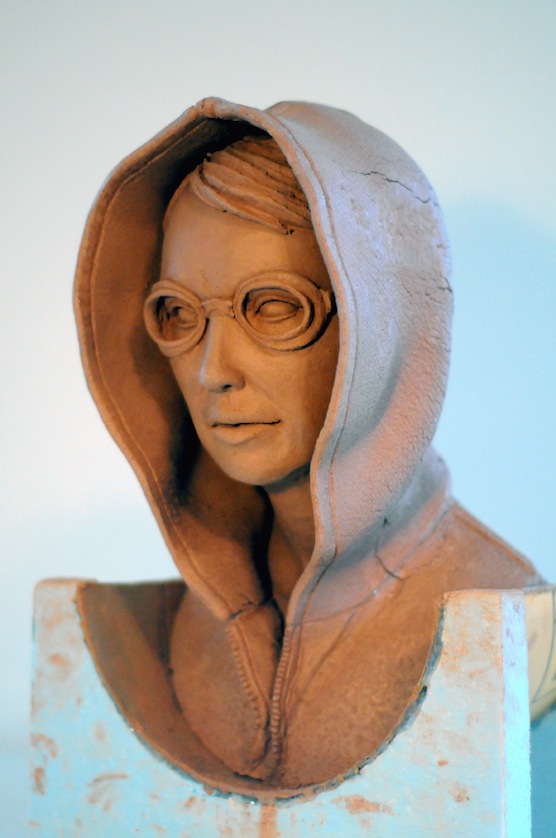
KH: Can you speak a little more broadly about the Unnatural Histories series?
All of the pieces are colored pencil on paper and are approximately 24 x 36 inches, to give you an idea of scale. I really enjoy the drawing process and probably spent approximately a month on each one, working on them when I wasn’t working on my clay pieces. So they aren’t things that happen quickly. They are things that I was really thinking about and working through physically, the actual making process, and conceptually. They‘re called my Unnatural History drawings because I’m referencing the visuals of Audubon works, to give you the idea of the naïve backpacker and of exploration, but also an idea of confusion and mistakenness. For example, when looking at some of the earliest drawings when people discovered the United States–even the map-making–everything is very inaccurate and, yet, they still had that spirit of discovery, and the drawings are that way as well. Each one of them deals with a different aspect, and all of these are from my travels in Indonesia, and they are about different social issues I encountered over there. They’re not meant to necessarily lecture to someone or say, “This is how it should be.” A lot of them are explorations into social things that maybe I don’t understand or maybe I don’t agree with. Maybe I’m still trying to chew up an experience in my head. I was fortunate enough to be able to travel to some remote places with some anthropologists. And so these are unique experiences that not everyone has, and I’m also sharing those sorts of things with the viewer. A lot of them are just reflections on that.

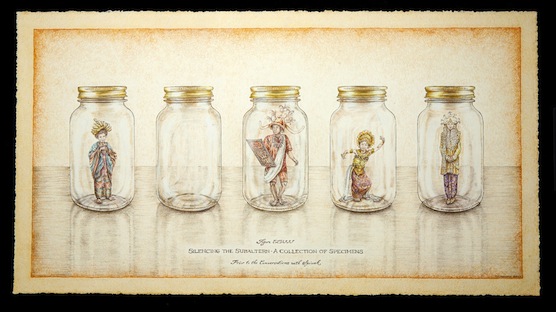
AP: How has your experience here at the Craft Center influenced your personal practice as an artist?
One of the wonderfully challenging aspects of this particular residency is that, in some ways, you are being critiqued on your work on a daily basis, which has been incredible, and it’s just through innocent questions and people not quite understanding. When you do have people coming in your studio every day, and you’re explaining yourself, you are forced to hear yourself say the same things, over and over, and it really does make you reflect on: “Why am I making what I do? What can I do in the future with that? How can I improve things?”. It really has been a great experience, and I feel very fortunate to have had this particular residency, because HCCC’s is a very public one, more so than other places, where you have quiet, private studio time. It has also made me think about my impact on the people who come to visit. It’s definitely made me think about what I’ll do in the future, and it has also been a great opportunity, because a lot of my work is about communication, and this has given me a chance to not only visually communicate my stories to people but also verbally.
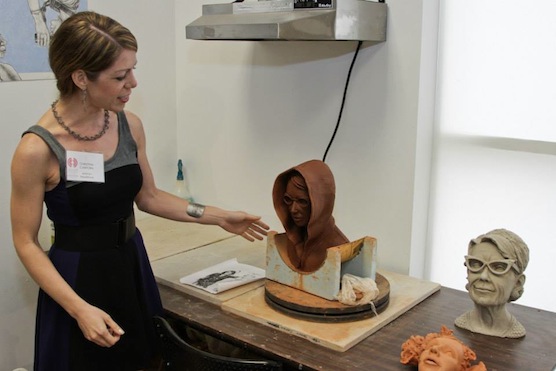
KH: Do you have any advice for someone who is looking to apply for a residency program?
Personally, one of the things that pains me is having to write artist statements. Every artist dreads it, and yet it is incredibly important for you to be able to really know yourself and what your work is about. It also guides you when you do have that idea of where you’re going with your art. I would often try to not think about the artist statement until I had to, but really taking the time to do this is very helpful. Having good photographs taken of your work is also very beneficial, and having a website is very important as well. This is something that took me a little bit of time, because I needed the images, and it’s a lot of work, but people can then reference my work and continue to explore it at any time.
AP: What are your plans after this residency?
After this residency is over, I’ll be moving up to Denton, Texas, and I’ll be teaching some undergraduate classes in ceramics at Texas Women’s University. While I’m up there, I’m going to be enrolled as a graduate student, taking classes myself, and working in my studio. I’m very excited about some of the classes that I’ll be taking, and I’ll be focusing on some new techniques and surface treatments and, hopefully, also working in some other mixed media that can tie in to my work. I’m finishing up my Masters of Art right now, but I intend on continuing teaching, as well as working. I’m also applying for MFA programs around the country, so, hopefully, next fall, I’ll be enrolled in an MFA program.
